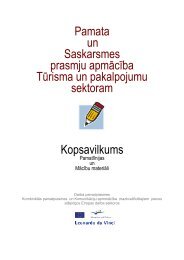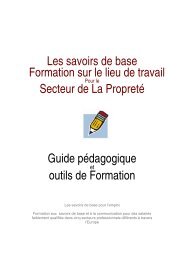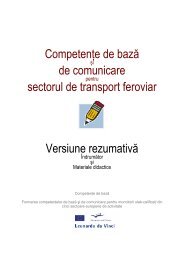Basic Skills Communication Construction Workers Executive Summary
Basic Skills Communication Construction Workers Executive Summary
Basic Skills Communication Construction Workers Executive Summary
Create successful ePaper yourself
Turn your PDF publications into a flip-book with our unique Google optimized e-Paper software.
NUMERACY<br />
Learning contents and purpose<br />
Focus on relation to workplace surroundings and relevance for everyday work!<br />
In order to empower employees with improved basic skills in numeracy, methods and tools in a course for construction<br />
workers shall primarily be related to tasks and duties included in actual jobs in this work area. Since it is, for example,<br />
of crucial importance to be able to mix materials correctly, learners shall be confronted with different exercises on<br />
volumes and measurements and be trained how to work out ratio and direct proportion. One of the aims of such<br />
trainings shall be to increase the learners’ awareness and knowledge of how to use mathematical information and<br />
language and how to identify suitable calculations to achieve an appropriate outcome (this is, for instance, important for<br />
doing or completing a materials list).<br />
The exercises attached are dealing with the following aspects:<br />
1 <strong>Basic</strong> numeracy skills, using mathematical information<br />
2 Using the basic arithmetical operations<br />
3 Practising common measures<br />
4 Practising common measures by converting<br />
5 Working out metric units of lengths<br />
6 Working out perimeter and area<br />
7 Working out ratio<br />
Other major elements of basic skills training for construction workers are:<br />
• Shape and space<br />
• Dealing with whole numbers<br />
• Negative numbers<br />
• Fractions<br />
• Decimal measures<br />
• Everyday percentages<br />
• How to work out metric units of width<br />
• <strong>Basic</strong> numeracy, arithmetic, calculation skills (e.g. for working out correct amounts of materials)<br />
Consider the following:<br />
1. Provide for an overall brush-up of basic mathematics (explanation and demonstration) and make sure<br />
each individual student understands contents (adding, subtracting, multiplying, dividing etc.)<br />
2. No pressure, provide enough time for students to do respective exercises<br />
4






